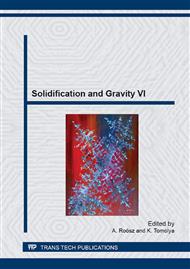[1]
G. Form and J. Wallace, Solidification of metals: General principles, Modern Casting 37 (1960).
Google Scholar
[2]
B. Chalmers, Principles of solidification, New York: John Wiley & Sons, (1964).
Google Scholar
[3]
M. Flemings, Solidification processing, New York: McGraw-Hill, (1974).
Google Scholar
[4]
R. Morando, H. Biloni, G. Cole and G. Bolling, Development of macrostructure in ingots of increasing size, Metall. Trans. 1 (1970) 1407-1412.
DOI: 10.1007/bf02900262
Google Scholar
[5]
A. Ohno, Solidification: The separation theory and its practical applications, Berlin: Springer, (1987).
Google Scholar
[6]
R. Doherty, P. Cooper, M. Bradbury and F. Honey, On the columnar to equiaxed transition in small ingots, Metall. Mater. Trans. A 8A (1977) 397-402.
DOI: 10.1007/bf02661748
Google Scholar
[7]
K. A. Jackson, J. D. Hunt, D. R. Uhlmann, T. P. Seward, On the origin of equiaxed zone in castings, Trans. Metall. Soc. AIME 236 (1966) 179-158.
Google Scholar
[8]
T. Wang, S. Yao, X. Zhang, J. Jin, M. Wu, A. Ludwig, B. Pustal, A. Bührig-Polaczek, Modeling of the thermo-solutal convection, shrinkage flow, and grain movement during globular equiaxed solidification in a multi-phase system: I. Three-phase flow model, Acta Metall. Sinica 42 (2006).
DOI: 10.1179/136404605225022874
Google Scholar
[9]
M. Ahmadein: Experimentation and modeling of grain nucleation and solidification of aluminum alloys in absence and presence of shear, Ph.D., Foundry Institute at RWTH-Aachen, Germany, Shakerverlag, (2009).
Google Scholar
[10]
Ph. Thevoz and M. Rappaz, Modeling of equiaxed microstructure formation in casting, Metall. Trans. 20A (1989) 311-322.
DOI: 10.1007/bf02670257
Google Scholar
[11]
M. Rappaz and Ch. -A. Gandin, Probabilistic modelling of microstructure formation in solidification processes, Acta Metal Mater. 41 (1993) 345-360.
DOI: 10.1016/0956-7151(93)90065-z
Google Scholar
[12]
M. Ahmadein, B. Pustal, R. Berger, E. Subasic, A. Bührig-Polaczek, Grain nucleation parameters for aluminum alloys: Experimental determination and model validation, Metall. Mater. Trans. A 40A (2009) 646-653.
DOI: 10.1007/s11661-008-9738-4
Google Scholar
[13]
J. Hunt, Steady-state columnar and equiaxed growth of dendrites and eutectic, Mater. Sci. Eng. 65 (1984) 75-83.
DOI: 10.1016/0025-5416(84)90201-5
Google Scholar
[14]
M. Martorano, C. Beckermann and Ch-A. Gandin, A solutal interaction mechanism for the columnar-to-equiaxed transition in alloy solidification, Metall. Mater. Trans. A, Vol. 34A, 1657-1674, (2003).
DOI: 10.1007/s11661-003-0311-x
Google Scholar
[15]
M. Wu and A. Ludwig, Modeling equiaxed solidification with melt convection and grain sedimentation – I: Model description, Acta Mater. 57 (2009) 5621-5631.
DOI: 10.1016/j.actamat.2009.07.056
Google Scholar
[16]
M. Wu, A. Fjeld and A. Ludwig, Modelling mixed columnar-equiaxed solidification with melt convection and grain sedimentaion – Part I: Model Description, Comp. Mater. Sci. 50 (2010) 32-42.
DOI: 10.1016/j.commatsci.2010.07.005
Google Scholar
[17]
M. Ahmadein, M. Wu, J.H. Li, P. Schumacher, and A. Ludwig, Prediction of the as-cast structure of Al-4. 0 Wt. Pct. Cu ingots, Metall. Mater. Trans. A 44A (2013) 2895–2903.
DOI: 10.1007/s11661-012-1606-6
Google Scholar
[18]
M. Ahmadein, M. Wu, A. Ludwig, Numerical study of the influence of mold filling conditions on the as-cast structure of Al-4 wt. % Cu ingots, ICET2012 (Int. Conference on Engineering Technology). 10-11. Oct. 2012, New Cairo City, Egypt. Conference Booklet, art. No. 6396110.
DOI: 10.1109/icengtechnol.2012.6396110
Google Scholar


